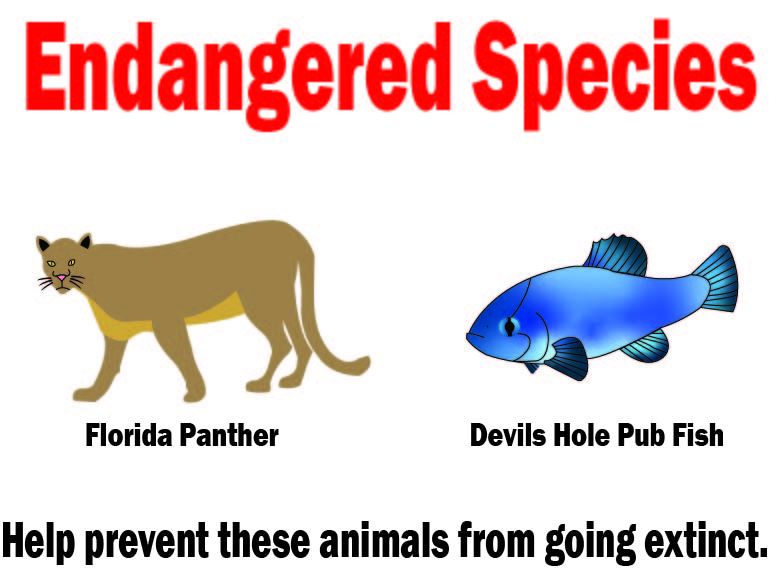Species Worth Saving: An Expedition Across America
December 1, 2021
During the Trump administration, it was announced that a major overhaul to the Endangered Species Act would reduce regulations. Environmentalists said the changes would push more and more animals to extinction due to threats from climate change and human activities. Those changes ended blanket protections for animals newly deemed threatened and allowed federal authorities to begin weighing the economic cost of protecting a particular species. Conversely, junior Kallen Rundle states, “It would take a massive effort. We would need to reserve a lot of time and space for rehabilitation.”
Starting with the vibrant poster image of endangered species, the Monarch butterfly. When asked which species she thought were endangered, sophomore Riley Marinos states, “The Monarch butterfly is the most common example I know.” With its count falling to the low tens of thousands in the western United States last year, the monarch is now under government consideration for listing under the Endangered Species Act. For Monarchs, farming and other human development have eradicated state-size swaths of native milkweed habitat, cutting the species numbers by 90 percent over the past two decades. The destruction to their milkweed habitat comes as a direct result of housing expanding into their territory, along with the use of pesticides and herbicides increasing. Many share remembrance for these exotic looking creatures, as freshman Samantha Betts states, “I think the Monarch butterfly and Orca whale when it comes to endangered species.”
Similar to our small, many legged friend, the Franklin’s Bumblebee has only been sighted once in the last 2 decades. Much of what we know about the Franklin’s Bumblebee, last sighted in 2006, comes from a retired entomologist, Robbin Thorp. His unpublished reports indicate that populations have drastically decreased since 1998, to such an extent that not a single bee was spotted between 2004 and 2005. This rare Bumblebee, one of more than 20,000 apian species, is only found between southern Oregon and northern California. In general, the largest threats to bumblebees include exotic diseases introduced via commercial greenhouses, habitat destruction, and agricultural pesticides. We often will not associate pesticides with pollution, as they benefit our commercial agriculture, but Rundle states, “Pollution is becoming the biggest issue.”
Flying high among our winged friends, the California Condor was thought to have perished for good back in the 1980s, but an intensive captive breeding program brought them back from the edge of extinction. By 1987, California Condors, which have historically been found between British Columbia and Baja California, were extinct in the wild. That year, the last six wild members of the species were captured for a breeding recovery program. Thankfully, the program was successful, yielding a population of 223 birds by 2003. The species’ decline has since been attributed to lead poisoning, from the accidental ingestion of bullet fragments stuck in carcasses, and to reduced eggshell thickness related to ingesting the pesticide DDT. War materials have become increasingly manufactured in the tense decades following the Cold War. Senior Keeley Harris states, “Production of some materials causes more pollution than others. Some of those materials have become more important to us over the years.”
At the very opposite end of our soaring species, the Ozark Hellbender is a less commonly known, peculiar, aquatic salamander found in Missouri and Arkansas. The species only lives in the White River watershed. The Ozark Hellbender is nocturnal, usually hiding under large rocks during the day. They can survive for up to 30 years in the wild, but recently, ore and gravel mining as well as nutrient and toxic runoff have significantly harmed their habitat. When asked the previous question, Marinos came to a similar conclusion as Harris: “The Industrial Revolution set pollution in motion.”
Among our aquatic oddities, the Sawfish is like a shark or ray, in that Smalltooth Sawfish are members of a cartilaginous group of fish called elasmobranchs. The Smalltooth, found mainly in the peninsula of Florida, is one of two sawtooth species native to the United States. They are also found as far away as Honduras and Sierra Leone. Measuring between 18 and 25 feet long in adulthood, Smalltooth Sawfish can weigh up to 770 pounds. Due to their size, Smalltooth Sawfish can damage fishing gear and pose a threat to fishermen. When they are captured by mistake, they are often killed. Juvenile fish, which live in shallow areas abundant in vegetation, such as mangrove forests, are imperiled by habitat loss. Their unique saws are also dried and sold as trinkets in some cultures. These creatures easily fall victim to hunting. Betts states, “Hunting went unregulated for some time. We must have eliminated or endangered some species before we had set restrictions.”
More commonly known in the sea, the Atlantic Bluefin Tuna provides a surprising 15 percent of all animal protein consumed by human beings. Of greatest concern is the western Atlantic Bluefin Tuna, but their species has declined by more than 80 percent since 1970 due to overharvesting. Prized as a sushi fish around the world, it has become as valuable as it has become rare. The large, warm-blooded Bluefin Tuna is a common, upscale sushi menu item and has been severely overfished in the Gulf of Mexico. The Atlantic Bluefin, like so many other ocean species, is threatened by humans’ ravenous appetites. We often do not consider our own habits, so when asked what impact she personally had, Marinos states, “Eating meat, but those species are not endangered.”
Last but not least, closer to home we have the Woodland Caribou. Betts states, “Possibly wolves or bears [are endangered] most likely mammals hunted for sport.” She could not be more right; Woodland Caribou have been reduced to merely one small population in northern Idaho and Eastern Washington. The population, known internationally as the Selkirk population, is numbered at only 18 individuals. Forest fragmentation and degradation are the most dominant threats to them, but the health of the Woodland Caribou population is not only important for their species, but for the health of the boreal forest itself. With such critically endangered species on close grounds, Betts says, “I read some articles and try to donate where I can.”
It is important to remember how these species will carry their legacy, with each species having their own set of skills and adaptive variations. It would be a national tragedy to see any of them disappear. In our state of Washington, Conservation Northwest is working with conservation groups in Canada to establish a recovery plan agreement for the Woodland Caribou, which is in the process of being legislated. Finally, Harris states, “Those organizations should be responsible for using the right resources for the given species.”




